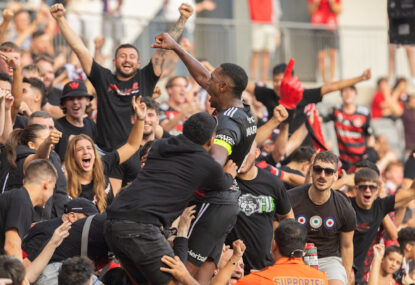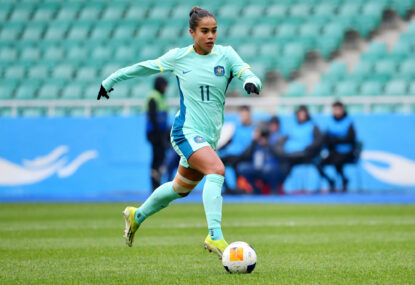As Football Australia announce a review into the Matildas’ failed Asian Cup campaign, there are some serious questions that need to be asked about the entire set-up of the women’s national team.
James Johnson insisted yesterday the review was about finding solutions to the problems that led to the Matildas being knocked out in the quarter-finals, their worst-ever result in the competition.
“We’re having conversations with the players, with the staff, with the coaches and the technical experts about what we did well and what we did not do well in India,” Johnson told AAP.
“In the next two-to-four weeks we’ll have some practical outlooks which will be in form of recommendations and we’ll accept those and move forward and grow as a team and an organisation in doing so.
“This process is not a review into any particular person, including Tony.
“It’s about trying to be open and honest and having dialogue about things that weren’t good enough and weren’t up to scratch.
“It’s certainly not a witch-hunt for any individual.”
Despite Johnson’s claim that Gustavsson isn’t in the gun, it is understood his relationship with the dual World Cup-winning assistant isn’t as strong as it perhaps should be.
However, Gustavsson has plenty of support within FA circles, with a number of key figures supporting him despite his poor record since taking over last year.
These figures and the influence they have is something that won’t be part of the review, but perhaps should be.
It has been long suggested there are certain cliques within women’s football that have had far too much say with what happens within the Matildas’ camp.
In what is an intriguing situation, the same clique that worked towards removing former coach Alen Stajcic appear to be the same group vouching for Gustavsson to keep his job. This is despite the Matildas winning only six out of 20 games since he took over, with three of them against lowly-ranked teams in the group phase of the Asian Cup.

(Photo by Mitchell Leff/Getty Images)
The results have incurred the wrath of Australian football fans, who have demanded improvement in the Matildas’ standards, with a home World Cup only 15 months away.
One question that surely must be raised is how much impact the Swede is actually having on the team, particularly with the development of the younger fringe players.
Gustavsson won’t be based in Australia until September this year, a key part of his negotiated contract with FA. In his absence, Mel Andreatta has run a number of camps in Australia in the lead-up to key international games including the Asian Cup.
Gustavsson has watched the training sessions via video and communicated with the players and Andreatta via zoom.
Andreatta is an experienced coach, but her relationship with some players isn’t the best. This is not uncommon for coaches and players but with Gustavsson not physically present, it presents an obstacle in overcoming any hiccups that are inevitable in any national team camp.
How this set-up works under the nose of the FA is bizarre.
Another fascinating bit of information is the amount of support staff that went to India with the playing squad. It has been confirmed by an FA spokesperson that 20 support staff were there for the 23-player squad. Of the 20, only four were coaches.
Of the four coaches that went to India, one was fellow Swede Jens Fjellstrom, who was apparently only there for the Asian Cup. It is believed Fjellstrom is not a permanent part of the Matildas staff.
For Gustavsson to take only three other coaches with him isn’t unreasonable. Too many cooks can spoil the broth after all, but one wonders why there were 16 other staff there and what their roles were.
Medical staff are a given, but the bulk of those other 16 were apparently more admin.
Twenty is the maximum number of non-playing staff that were allowed at the Asian Cup by the AFC. It is unclear how many other countries used their full allocation.
Twenty may seem high, but apparently there are sometimes up to 25 non-playing staff that travel with the Matildas or Socceroos at any given time.
There were some eyebrows raised when the Matildas didn’t compete in the Algarve Cup in Portugal last month after their trip to India, with murmurings the cost of travelling was an issue. With 43 members in a touring party, it would have hit FA’s cash flow hard. The governing body has lost $8.2 million in cash over the past two financial years.
FA have never said that finances were the reason for the Matildas not going to Portugal, they instead cited player and support staff welfare as the main reason, with the Matildas playing 80 per cent of their matches away since last March.
The support staff contention was interesting, especially since the Asian Cup travel schedule was for only three weeks, and prior to that the Matildas squad hadn’t played overseas since 22 September 2021, when they visited Ireland for a one-off international. Three weeks out of four months wouldn’t seem excessive to a reasonable person.
The player welfare contention was also baffling since it would have been reasonable to use the last international window to blood Australian-based fringe players, many of whom have been starved of game time over the last few years, especially at the international level.
The European-based players, who play full-time at club level, would have deserved a rest.
There were suggestions that some senior players were uncomfortable at the thought of younger players taking their spot. The cynics were also of the view that big losses against tough European competition wouldn’t have helped Gustavsson’s record. While these possibilities are just unsubstantiated rumours, they are all part of the sometimes murky world of the Matildas.
The above situations are magnified by the fact the team is losing. If they were winning, none of the above scenarios would be questioned. But the reality is, results are not as good as expected, so the hard questions have to start being asked.
Women’s football needs to be taken seriously at the highest level. The time for cliques and odd decisions is long gone. A World Cup is at stake in 15 months.



































































































